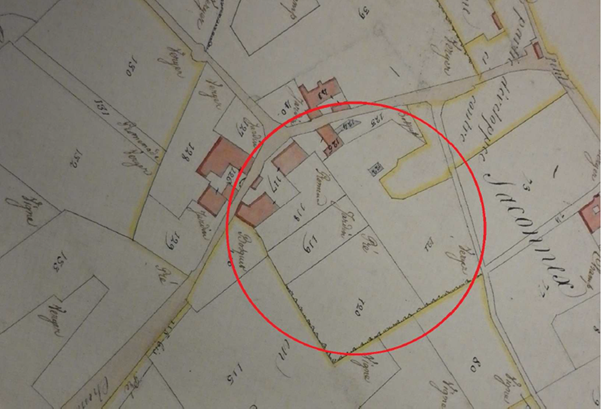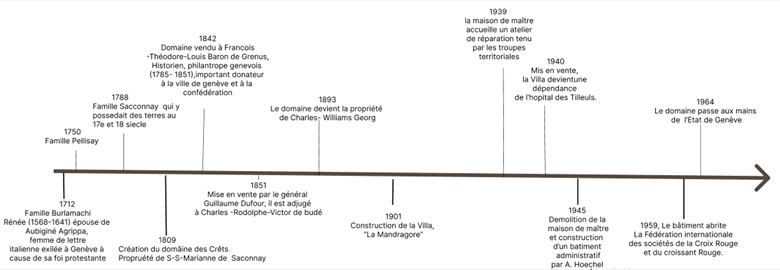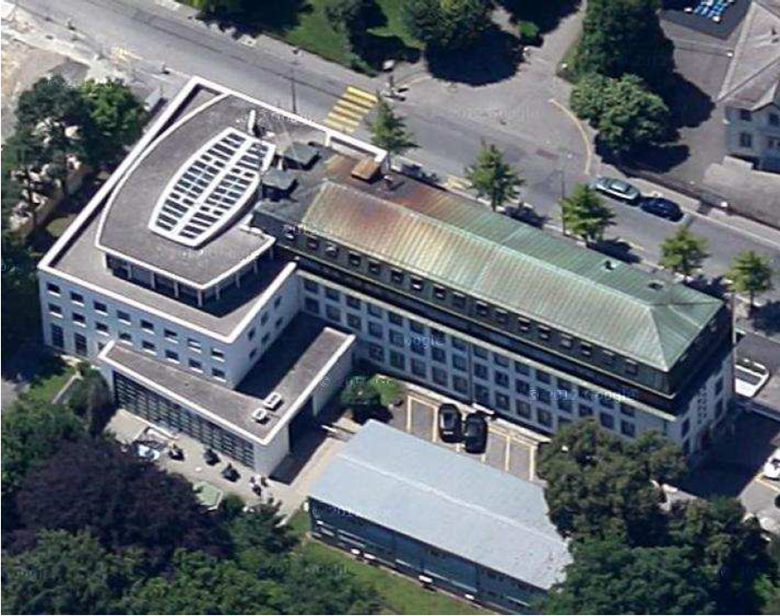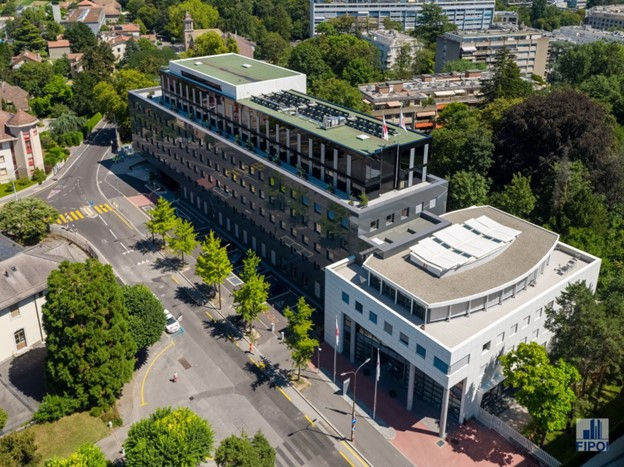BETWEEN A RURAL PAST AND “INTERNATIONALIZATION” FROM 1809 TO 2018

The Domaine des Crêts was created in 1809 and is located in Petit-Saconnex, one of the largest and oldest communes in Geneva. Benefiting from a privileged location on the line of the Crêts and an access opening on the village square, it has preserved in some places traces of a rural past.
Its originality lies in its historical trajectory, the origin of which goes back to the beginning of the 18th century. Indeed, the Domaine des Crêts has a rich history of important actors who have marked the century of the Enlightenment in Geneva and internationally, but also a particular history by becoming the headquarters of the International Federation of Red Cross and Red Crescent Societies, the largest humanitarian network in the world. This journey of more than two centuries of history marked by profound changes, deserves to be revisited in order to highlight the richness and the past of this place..
This article realized by the urbz collective within the framework of the IFRC park project aims to elucidate the historical originality of the place from its origins to its "internationalization". This return in time also allows to understand the existing interactions of the place with the neighborhood and their evolution over the years in order to co-construct on this basis a project that significantly improves the development of social links through a sustainable management and a greater accessibility of the park by the public.
The choice of the chronological limits is not fortuitous; it is determined by the historical facts that have marked the history of the domain. Indeed, 1809 corresponds to the date of creation of the domain, which evolved between different owners under private ownership, with limited access, before becoming the IFRC headquarters after World War II, in 1959. 2018 marks the commissioning of the new IFRC building, influenced by the consultation of the staff, neighborhood and all local authorities, proof of the commitment of the IFRC to collaborate with the neighborhood and the inhabitants of the area in a collective approach as a fundamental principle of the project.
The Domaine des Crêts has been the subject of little research despite its particularly interesting history. As such, there is a report on the history of the Domaine des Crêts written by the Service des Patrimoines et des Sites in 2013, in preparation for the project to demolish the old building and construct the new IFRC building. Research carried out by urbz, the archives service, the iconographic service, the digital mediation service of the municipal library of Geneva and oral sources have provided additional data or information essential to the realization of this article.
This analysis is structured in three parts by chronological theme.The first part deals with the historical context from the 18th century until the formation of the domain in 1809. The second part is devoted to the period from 1809 to 1959, which marks an important milestone with the establishment of the League of Red Cross Societies. The last part traces the transformations that took place on the estate until 2018, the date of the inauguration of the new IFRC building.
I- Origin of the Crêts estate from the 18th century until 1809
This domain was born from the division of a larger domain (photo 1), which belonged to several large families during the 18th century: the Burlamachi family (1712), Pellisay (1750) and Saconnay (1788). This first family, which had adhered to the Protestant faith, emigrated first to France before taking refuge in Geneva. One of the important characters of the Burlamachi family who marked the history of Geneva, was the memorialist Renée Burlamacchi (1568-1641). She settled in Geneva in 1585. With her children to escape the Wars of Religion, she married in 1623 the famous Theodore Agrippa d’Aubigné, a man of letters. Her writings constitute a documentary work that sheds light on the life of women of her time, their role and their impact. She died in Petit-Saconnex on September 11, 1641. One of the descendants of this family was the Genevan jurist, Jean Jacques Burlama who was the first theorist of natural law. Author of numerous works on political law and the law of nature, he taught law at the University of Geneva until 1740.
Photo 1 : Vast lands from which the domain of Les Crêts was born.

Source: office du patrimoine et des sites, 1817.
II- The Domaine des Crêts from 1809-1959
Created in 1809, the Domaine des Crêts belonged to Suzanne-Sophie-Marianne de Saconnay, wife of Bertrand-Ferdinand de Watteville, and included a manor house with its outbuilding, on both sides of a courtyard (117) located on the ridge line, a stable, a barn, a terrace (118), two carpieres (122 and 124), a garden (119), orchards (121), and vines.
Photo 2 : Domaine des Crêts around 1810, cadastre E.

Source: office du patrimoine et des sites.
2- Transformation with the arrival of the tramway in 1894
As early as 1882, the idea of creating an electrified line in Geneva, on the Petit-Saconnex - Champel axis, was being considered. However, it was not until a dozen years later that everyone agreed. This line, which was finally inaugurated on September 22, 1894 by the Swiss Tramway Company (photo 2), transformed the morphology of the heart of Petit-Saconnex, and with it, the Domaine des Crêts. The report of the heritage service mentions this transformation:
“In 1894, the arrival of the tramway in the heart of the village and the reinforcement of the status of the square lead, two years later, to the displacement of the access of the property in the direction of the Petit-Saconnex square. The alley is closed by an imposing wrought iron gate and is bordered by a janitor’s house. The gate is extended by a fence that extends for about thirty meters. In addition, to the west of the property, the route of the chemin des Crêts is straightened so as to provide a walkway for the residents of the neighboring retirement home” (Report ops-sms, 2013, p.3)
Photo 2 : Petit-Saconnex-Place

Timeline of the evolution of the history of the Domaine des Crêts.

The oldest and most interesting elements of the property are the pavilion on the edge of the terrace, the janitor’s house, the park and the gate.
a- “Caretaker’s house” chalet
The chalet, still called “Maison de gardien” or “Maisonnette”, built in 1896 with an initial implantation at the property limit, with an external staircase. The visit report established by the service of monuments and sites of the Office du patrimoine et des sites on the history of the Domaine des Crêts, in preparation for the demolition project of the old building, provides information on the chalet. This house (Photo 5) appears in the images taken from the album in homage to Charles Georg, former mayor of the commune of Petit-Saconnex, from 1902 and owner of the Domaine des Crêts. He had received this album from his wife for their 25th wedding anniversary.
The chalet, of the same model as the one existing at the entrance of the Budé farm, has an architecture of Swiss house type. It was a very common way of building janitor’s houses at the time, which served the security function of the estates, due to their strategic position at the entrance of each estate.
Outside the chalet, you can see the park, and a pond, probably fed by a stream (natural nant) fed in turn by the waters of the Jura (photo 6). Some historical information mentions the park in the newspaper, number 5 of the Association des Habitants du Petit-Saconnex-Genève (AHPTSG) entitled les Nouvelles du Petit-Saconnex:
“The real village square was then located at the intersection of the Chemin des Crêts, the Chemin du Four (the current Chemin Dr. Adolphe-Pasteur) where the oven of the old bakery was located and at the height of the gate of the Georg house which became the gate to the park leading to the new building of the International Federation of Red Cross and Red Crescent Societies (IFRC). This was also the site of the gallows, which was destroyed and replaced during the French occupation by the “tree of freedom”. This small square was called “Colas”. It is said that at the foot of the gallows grew the “mandrake”, a plant which was said to have the most wonderful properties in the Middle Ages.
This park has the particularity of being a very quiet space, which preserves the traces of its past and a value of important green frame within the district.
Photo 5 : Pictures of the domaine des Crêts in 1899.

Source: Centre iconographique de Genève.
b- The hexagonal belvedere pavilion
In addition to the small chalet, the hexagonal belvedere pavilion is one of the only vestiges that has withstood the test of time and has been preserved on the domaine des Crêts. Of neoclassical type with mosaic pavement and painted ceiling, it was built around 1920 at the edge of the terrace of the mansion and near a bowling alley.
Since its creation in 1809, the Crêts estate remained relatively unchanged until the turn of the 20th century. After having known various owners and served different needs, the domain, in the aftermath of the Second World War, passed into the hands of the consumer cooperative society which had an administrative building constructed in 1945 by Arnold Hoechel (photo 3) to replace the mansion demolished in 1945. This first intervention will be followed by others, which, without an overall vision for the site, will harm its coherence.
Photo 3 : The administrative building, built in 1945 and enlarged in 1994.

III- Domaine des Crêts 1959-2018: “internationalization
The new administrative building built in 1945 houses since 1959 (photo 4) the League of Red Cross Societies marking the integration of the Crêts domain to the international Geneva.
Photo 4: Headquarters of the League of Red Cross Societies in1959.

Copyright: Jean Zbinden, Genève, 24 juin 1959 Vidéo de l’inauguration en 1959
This installation is accompanied by the realization by the architect Pierre Varenchon of an administrative building of square plan and by the restoration, still by Pierre Varenchon, of the old outbuilding. In 1994, the administrative building was extended to the south. (photo 5)
Photo 5: Expanded building in 1994 to the south.

Source: rapport OPS-SMS, 2013.
Another extension was made three years later in 1997 by Georges and Jean-Noël de Guili.
In preparation for the new building project, the historic post-World War II building and several small temporary gasoline buildings were demolished to make way for a new IFRC building. Only the 1997 extension, the small chalet and the hexagonal belvedere pavilion are still preserved.
Photo 6: New IFRC building commissioned in 2018.

Source: FIPOI, 2022
The establishment of the League of Red Cross Societies positively transformed the relationship between the inhabitants of Petit-Saconnex and the property. This mutation is marked by a great opening of the place to the public which was until then in private hands. The participatory approach of the architects of the new building, the current IFRC headquarters, with the local actors (local residents, EMS, associations) is a strong sign of the IFRC's will to promote social integration and community action. The institution has considered including in the program a self-service restaurant open to anyone in order to make its spaces more accessible to the public. The IFRC is committed to an evolutionary vision based on the fundamental principles and values at the heart of its actions. It is committed to a dynamic relationship of proximity and to the opening of its outdoor and indoor spaces to the general public and to the inhabitants of Petit-Saconnex in particular. This is evidenced by the weekly events organized by the Association des habitants du Petit Saconnex-Genève at the chalet and the ongoing project to transform the park and the IFRC's outdoor spaces. This project aims to make the IFRC park a humanitarian hub, open and accessible to all, by offering a welcoming space that strengthens social ties and promotes social and community integration through a participatory approach with all stakeholders and local authorities.
BIBLIOGRAPHY AND SOURCES
Report
Rapport de visite de l’office du patrimoine et des sites du 16 mai 2013-Bénédict
Frommel, 20 p.
Webographie:
https://100elles.ch/biographies/renee-burlamacchi/ consulté 23.11.2022.
Service de médiation numérique de la Bibliothèque municipale de la ville de
Genève, interroge.
Réponse de interroge du 03.06.22 sur les informations historiques du Chalet
attenant au siège de la FICR:http://institutions.ville-geneve.ch/fr/bm/interroge/
questions-recentes/questions/detail/auriez-vous-des-informations-sur-lhistoriquedu-
chalet-attenant-au-siege-de-la-federation-de-la/
Réponse de interroge sur sur l’historique ( photos et plans)de l’immeuble de 1945-
1946 de Arnold Hoechel, siège de la ligue des sociétés de la croix rouge et du
Croissant-Rouge aujourd’hui Fédération de la Croix-Rouge situé au 17, chemin des
Crêts au Petit-Saconnex.
Archives
Services des archives de l’Etat de Genève, Département du Territoire
Iconographic sources
Bibliothèque de Genève iconographique, Album hommage à Charles Goerg, Fred
Boissonnas et Rodolph schlemmer
Interviews
Entretien du 23.11.22, au siège FICR avec Bernard Lescaze, historien, spécialiste
de l’histoire moderne.


Comentários